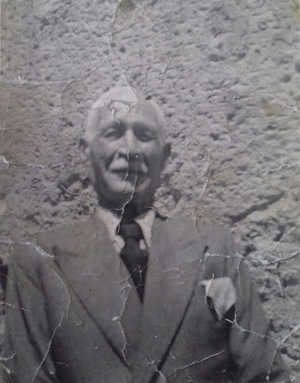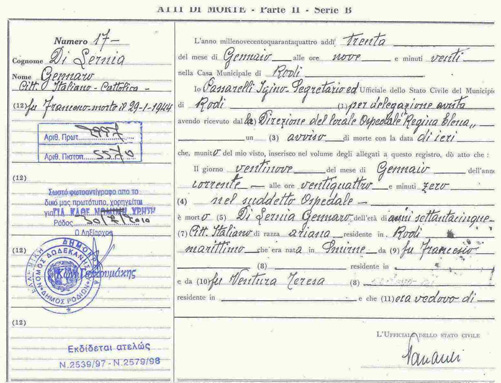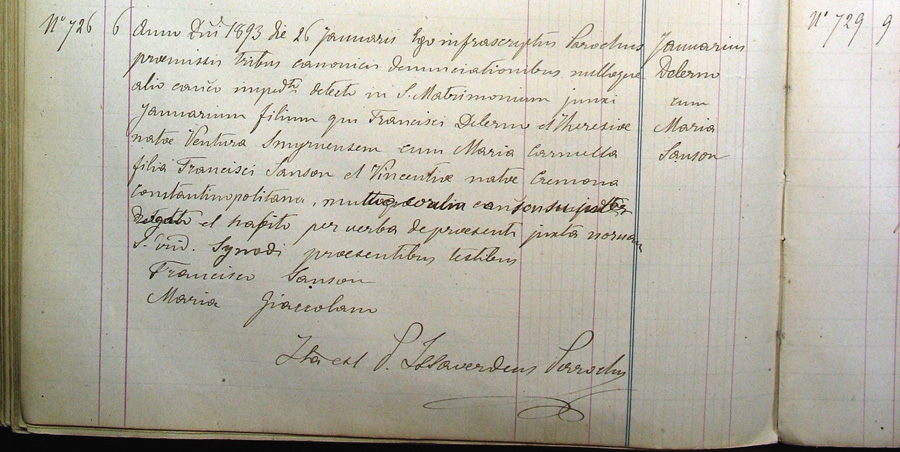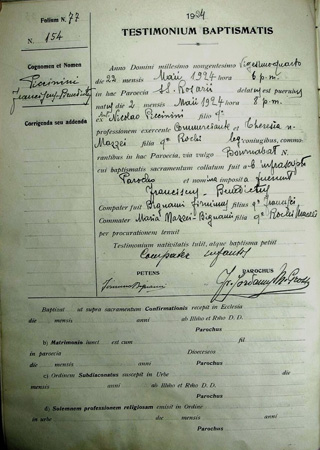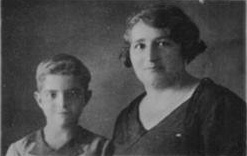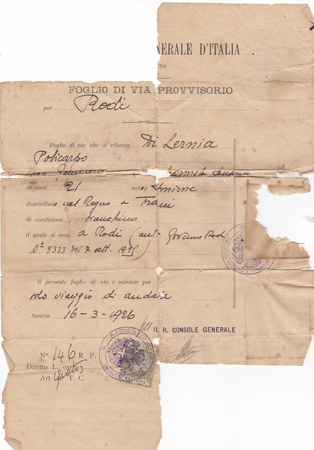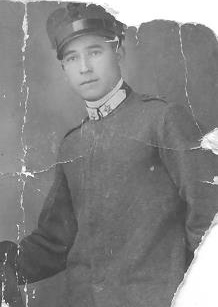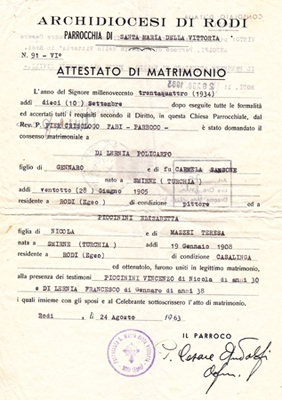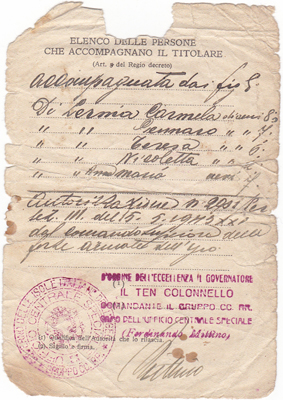
The Contributors
THREE GENERATIONS OF ITALIANS IN IZMIR: A BRIEF HISTORY OF MY FAMILY - in Italian
by Anna Laysa Di Lernia

I am grateful to Mr Alex Baltazzi, Ms Marie Anne Marandet and Mr Fabio Tito for the information supplied in the last months. Without their help and their deep knowledge of the history of Izmir I would not have been able to trace back the origins of my family. When I began this research I did not even know who the first ancestors were to move from Italy to Turkey. Now many details are clearer and supported by documents (kindly provided by Ms Marie Anne Marandet), even if there are still many shadows in the story.
With this document, I am trying to get in touch with anybody who may have known some of my ancestors or may be somehow linked to the family (I really don’t know if any Di Lernia and Piccinini are still living in Izmir), to collect as much information as possible.
Origins of my family name
My name is Anna Laysa Di Lernia, I was born in Italy where I still live, near Milan, but my father, my grandfather and my great-grand father were born and lived abroad for more than a century before my birth.
From what I was able to find out, my ancestors arrived in Izmir from Italy around 1850. In those years a group of men of the Delerno family, probably brothers and cousins almost the same age, moved from Trani, near Bari (Apulia, Italy).
According to the documents of the Italian Consulate1, the original name of my family was Delerno, but some members changed it into Di Lernia2. Nevertheless, in the parish registers the surname was written in many different ways for many years (Delerno, De Lerno, Dellerno, Dilerno, Dillernia).
On the basis of documents it seems that four/five progenitors settled in that period in Izmir:
- Domenico Delerno/Di Lernia, who died before 18803, was married with Maria Mastropasqua and had a son, Nicola, born in Izmir in 1848;
- Domenico Delerno/Di Lernia, who died before 1871, was married to Maria Carabotti or Carabetti, born in Malta in 1824, and had seven children from 1850 to 18634
- Spiridione Delerno, who died before 1880, was married with Anna Mirzan (or Mizzi), born in Izmir in 1835, and had three sons from 1859 to 1866;
- Francesco Delerno/Di Lernia, son of Giuseppe and Rosa Modina or Medino from Barletta, born in Trani 15.11.1834. He was married with Teresa Ventura, also born in Trani 30.11.1840, and in Izmir they had seven children between 1862 and 1879, when Francesco died at the young age of 455;
- Vincenzo Delerno, son of Giuseppe from Trani (died before 1872) and Maria Desanti from Bari, born in Izmir, in 1848. He was a mason and a sailor, married to a woman born in Trani, Saveria Ragno, and in Izmir they had eight children from 1871 to 1889. He died in Izmir on 26.10.1890, at the age of 42 years.
Apulian migration to the East
In the years between 1830 and 1860 a certain number of families coming from the Apulia region, and specifically from the villages of Trani, Molfetta, Barletta and some others on the coast near Bari, left their country (in those years Kingdom of Naples) and settled in the Levant. According to an essay by Biagio Salvemini6 about the Apulian fishers in the period between the middle of 18th century and the years 1830s, there were economic and historical reasons for this migratory flow. During the last fourth of the 18th century, the fishers of the above-mentioned villages adopted a new fishing technique called “alla gaetana” (from the port of Gaeta where it was introduced). It consisted of a trawl dragged by two light and fast boats called “paranzelli”, which allowed to catch faster an increasing amount of fish and could meet the demand of an increasing population. Moreover, the Apulian fishers took advantage of the fact that trawling was restricted for the fishers of the Neapolitan coast, so that they were fishing all year long in different areas of the Mediterranean sea. The economy of the area had a great development and the fishing fleets of Trani, Molfetta, Bari, Barletta entered in competition with each other.
In the years 1815-1820 Trani was the most important fishing harbour of the coast, but in the following years the situation changed: around 1850 the paranzelli of Trani were more frequently used for commercial trips and its fishers got used to long transfers which kept them abroad for months or years. The figures of the census for the village of Trani show that by the year 1861 at least 3% of the population, generally male fishermen, had emigrated, and the percentage raises to 4.5% between 1861 and 1871 and is 3.7% between 1871 and 1881.
The reasons for this phenomenon are different: the growth of Molfetta and Bari as fishing ports and that of Bari as a commercial harbour, which caused a slow decline of Trani; the fact that some men from Trani knew the Levant harbours and its facilities7 and they preferred to take these new opportunities; some incentives granted by the Russian Empire for settlements in Crimea; in some cases also political reasons (some followers of Garibaldi left the area before the Italian union).
A very interesting documentary was published some years ago by Tito Manlio Altomare, called “L’olocausto sconosciuto degli Italiani in Crimea” (The unknown holocaust of the Italians in Crimea). It tells the almost completely unknown story of some fifty Apulian families, which moved from Trani to the village of Kerch, in Crimea (now Russia), to develop local agriculture and sea transports across the Black Sea in the same years we are considering. They were not poor emigrants like those leaving for America, but able seamen, often ship-owners, and skilled farmers who took advantage of new opportunities to develop their profession. There, the community became rich and important, but had a terrible experience after the Russian Revolution of 1917 and later (1934) with the “purge” of Stalin, when they were sent to the gulags, in Kazakhstan (it is possible to see this unique document here:
What is amazing is that the names of those families are often the same as the ones who settled in Izmir: Scagliarini, Ragno, Tito, Bassi, Fabiano, De Martino and (what was really a great emotion for me!) De Lerno. The journalist Tito Manlio Altomare interviewed some descendants of the De Lerno family, and I have been able to get in touch with one of them, a young lady called Nataliya, who still lives in Kerch. Another descendant, Marietta De Lerno, lives in Kazakhstan, where her family was deported, losing many members and all its fortune.
Without the documents from Izmir stating the original name of my family I would have never been able to connect the Russian De Lerno to the Levantine/Greek/Italian Di Lernia.
My line of descent
Francesco Delerno/Di Lernia is the progenitor of the branch I belong to. The documents do not provide other details about his wife, Teresa Ventura, even if the family Ventura is represented by a certain number of members in the following generations in Izmir. She was registered in the Italian Consulate register at n° 132 on April 24th 1879, three weeks after the death of Francesco, with the list of their children, and probably died on March 6th 1908, if she is the same person recorded in the parish register of deaths of the Holy Rosary Church (see Doc. 1).
According to some family stories, my ancestors moved to Izmir to work for the railway (ORC?) and in fact the first son of Francesco and Teresa, Giuseppe Di Lernia, born on January 5th 1862, is recorded as Dipendente delle ferrovie (Railways employee)8.
The second son of Francesco and Teresa was Gennaro Di Lernia, my great-grandfather, and after him they had five more children: Rosa9 in 1866, Policarpo10 in 1872, Antonio11, in 1874, Pasquale12 in 1877 and Nicola13 in 1879.
My great-grandfather Gennaro was born in Izmir on August 19th 1864. He was a sailor, specifically helmsman, and on January 26th 1893 he married Maria Carmela Sanson (or Sansum), born in Istanbul in 1875. Her birth place is stated in the register of the Cathedral, were the ceremony took place, but the family legend says that Carmela was born in Malta14 and since she was very beautiful and the Sultan wanted her in his harem, her parents (Francesco Sanson and Vincenza Cremona) sent her to Constantinople, to stay with an old aunt without children (see Doc. 2).
Somehow Carmela and Gennaro met; it might have happened during one of his trips as a helmsman: trade along the coast and up to the capital was intense in those years and it is plausible that with his boat he often went to Constantinople. Or maybe Carmela’s family had moved to Izmir. Gennaro was eleven years older that her, a blond/reddish haired man (his nickname was, in greek, “gharida”, prawn, also for his pale skin that reddened at the sun), with a big moustache, dressed in Turkish style. They eloped, probably to Izmir, where they got married, witness her father Francesco Sanson and a certain Maria Giaccolano (was her mother Vincenza Cremona dead?) (see Doc.3).
Gennaro and Carmela had eight children, all born in Izmir: Adolfo Francesco, whose nickname was Franzi, who was born on October 12th 1893 and died in Rhodes during WWII, Giovanni Battista, born on May 13th 1895 (see Doc. 4), Maria Alessandra, who was born on July 6th 1897 and died 10 months later, Teresa, who was born on April 11th 1899 and died in 1916 at the age of 17, Vincenza, born on June 6th 1903 (see Doc. 5), Policarpo, my grandfather, born on June 28th 1905 (see Doc.6), Luca, who was born on January 17th 1910 and died on February 5th 1911 for a neck abscess, as specified in the registration of his death (see Doc. 7), and Giuseppe Gabriele, whose nick name was Kuzuna, born in 1912.
Carmela died on June 7th 1923 in Izmir at the age of 48 (had she been involved in the fire?) and Gennaro never married again: he used to throw his stick to everybody who suggested that he should have a second wife (it seems that he was a hot-tempered man...).
After the great fire, probably due to the new laws imposed by the Kemalist government, Gennaro left Izmir (I don’t know exactly in which year, but surely after the death of Carmela, i.e. June 1923). He moved to the Island of Rhodes, which was Italian in those years, with his daughter Vincenza and his sons Franzi15, Policarpo, my grandfather, and Giuseppe Kuzuna16. I found among the papers of my grandfather Policarpo a “One-way sheet” for Rhodes issued by the Consulate General of Smyrna on March 16, 1926. Nobody in the family remembers the second son of Gennaro, Giovanni Battista as living in Rhodes, so maybe he didn’t leave Izmir: he had married in 1920 Elisabeth Portelli, daughter of Policarpo and Rosa Scagliarini, and they had three children (Gennaro, Carmela Antonia and Sofia Rosa). I have no information about this branch of the family (see Doc. 8).
My grandmother’s family: the Piccinini
Both my paternal grandparents were born in Izmir, from families who had settled there two generations before. About the Di Lernia I have already explained.
My grandmother’s ancestor was Filippo Felice Piccinini (he was generally called simply Felice), who was born in Molfetta (Bari – Apulia) on April 25th 1839, from Vincenzo and Maria Silvestri. He seems to have been the only member of his family to move to Izmir17. He was a seamen (“marinaio” is written in the Consulate register) and he was married with Teresa Frisani (or Frissano)18, daughter of Gaetano, born in Trani in 1850. They probably didn’t leave permanently Italy until 1877-78. In fact, according to the Italian Consulate register they had their first son, Vincenzo19, in Izmir in 1871, but the two following children, Maria (1873)20 and Gaetano (1876)21, were born in Trani, while the following seven children were all born in Izmir (the Italian Consulate document does not list them all), from 1878 to 1889.
Their names were Eleonora22, Nicola Antonio, my great-grandfather (about him I will talk later in detail), Luigi23, Policarpa24, Angela, Anna25 and Angela Anna26 (see Doc. 10).
Filippo Felice had quite a long life: he died in 1911, at the age of 72, due to chronic bronchitis, as recorded in the Cathedral register of deaths (see Doc. 11). On the contrary, his wife died young, only 45, in 1895.
Differently from the Di Lernia, who moved to Izmir as a family group and together with many other families from Trani, Filippo Felice’s settlement seems to be in line with the description of the economic and social situation of the village of Molfetta we find in the already mentioned work by Biagio Salvemini27. In the years 1850s, when fishers and seamen from Trani emigrated, Molfetta took Trani’s place as the most important fishing port of the Bari area.
From those years until the 1890s Molfetta kept its economic importance, but its fishers had to brave long and dangerous journeys to catch the fish required by the market: the registers of arrivals and departures from the harbour of Molfetta show that around the years 1870s many fishing boats were leaving for Greece and Egypt and stayed away many months. My ancestor may have been one of the seamen on those boats coming and going from and to the East.
Captain Barba Colé, my great grandfather
The fifth child of Felice’s and Teresa’s was my great-grandfather, Antonio Nicola Piccinini, born in Izmir on June 30th 1880 (see Doc. 12). He lost his mother when he was 15 and he probably began to work on boats with his father, becoming an able seaman and later a captain and owner of a small commercial fleet. His nick name was “barba Colè”.
On September 26th 1903 he married Teresa Mazzei, born in Izmir on August 30th 1882 (see Doc. 13 and Doc. 14). Teresa was the daughter of Rocco Mazzei28, born in Corleto Perticara (Potenza, Basilicata) in 1853, and Elisabetta (Laisa) Verdori (or Verdaki) born around 1862, who had married in Thessaloniki in 1880. Rocco was a musician. Teresa had five brothers and sisters: the first born was Egidio (born 1881) (see Doc. 15), then Antonio (born in 1884), Nicola (born in 1886), Maria (born 1887, who married in 1905 Polycarpo Piro, but in 1924 seems to be the wife of Firmino Bignami29, and later, in Rhodes, had another partner, a tailor called Gioacchino Segreto) and Angela (born in 1889 and died in 1892 at the age of 3 years) (see Doc. 16).
Nicola and Teresa had eight children. The first was Vincenzo, born in Izmir on January 24th 1904 and baptized in the Cathedral on February 25th, as shown in the document, godmother Maria Mazzei, Teresa’s sister (see Doc. 17).
The second son was Felice, born on March 7th 1906, who died at the age of 3 on July 27th 1909 (see Doc. 18 and 19).
The third born was my grandmother Elisabetta Laysa. She was born on January 19th 1908 and baptized on February 28th in the church of the Holy Rosary with her maternal grandmother’s name.
It seems, according to the parish documents, that the family had its residence in the Punta area until my grandmother’s birth, i.e. 1908, but later moved to the village of Bayrakli (see Doc. 20a-b-c).
In fact Laysa’s brother Felice died there in July 1909 and later her sister, Polina Antonia called Pola, was born on December 23rd 1909, at 7:15 PM, in Bayrakli, where she was baptized in the church of St. Antony on February 24th 1910, godparents Lucas Cauki and Emilia Mattesich (see Doc 21).
On April 18th 1911 Carlo was born, who was baptized on May 28th by Elisabeth Dickinson, a lady about whom I don’t know more than this. The ceremony took place, again, in the church of the Holy Rosary in Izmir: had the family moved back from Bayrakli? (see Doc 22).
What is certain is that between the end of 1911 and 1913 the family left Izmir and settled in Tripoli (Lybia), where in 1913 the sixth son was born, Egidio, called Gigi. Unfortunately there are no documents of his birth and it seems very difficult to get them from Lybia after all those years, as his son Edoardo confirmed to me recently (see Doc 23).
Up to 1915 the family was back in Izmir, where another son, Felice, was born on June 17th and baptized on December 6th, 1915 in the Holy Rosary Church, godmother his aunt, Eleonora Piccinini Filippucci, Nicola’s sister (see Doc 24 and 25).
The last son of Nicola and Teresa was Francesco. His certificate of baptism (see Doc. 26) is very interesting, because it reveals many details: in 1924 the family was living in Bournabat, where the child was born on May 2nd at 8 pm; his father Nicola had become a trader (commerciante); even if they lived in Bournabat, their parish was still the Holy Rosary Church in Izmir, where Francesco was baptized, godparents his mother’s sister Maria Mazzei and her (second? – see before) husband Firmino Bignami; Francesco did not receive his confirmation in Izmir, since the document does not mention it. In fact, some years later (but I don’t know exactly when) the family left Izmir and settled in the island of Rhodes, at that time Italian possession (Dodecanese Colonies).
My ancestors’ everyday life in Izmir
I really don’t know much about my ancestors’ everyday life in Izmir: my grandmother Laysa did not usually tell detailed stories about those years, so I only have short spots of her stay in Izmir. I know, for example, that she and her sister Pola attended a catholic school, probably a French one (Sacré Coeur?), because they used to say prayers in French; she hated boiled carrots because the nuns forced her to eat them, even if her father Captain Colè used to provide the school with fresh fish and many vegetables he traded; she used to describe the horrible scenes of the great fire, with the streets covered with dead people while they were rushing away. This episode made me believe that the family left Izmir on that occasion, but the birth of Francesco, my grandmother’s youngest brother, in 1924 in Izmir means either that they did not leave the town then or that they did leave Turkey in 1922 but, like many others, came back later.
A few words about my great-grandfather Nicola Piccinini. He surely was a resourceful man: he was a skilled sailor, he spoke six languages (Greek, Turkish, Italian, French, Arabic and some Hebrew) and was smart enough to take advantage of the increasing importance of Izmir as a commercial port. Little by little he became a trader, owner of a small commercial fleet: he used to remember that Ari Onassis had worked on his boats, before leaving for the U.S. (but I have no evidence of this tale).
Captain Piccinini was forced by the new laws of Kemal Atatürk to leave Izmir, since he wanted to keep the Italian nationality, but he probably had already arranged the settlement of the family in Rhodes, a port that he certainly knew through his trades. There, he continued his activities and even extended them. In fact he also became owner of a sawmill, of which old residents of Rhodes kept memory till some years ago, and he had some assignments at the port of Rhodes, according to family tales.
About the Di Lernias I have even less information. My grandfather Policarpo sometimes mentioned his passion for singing Smyrna love songs accompanied by the guitar he loved to strum.
The Di Lernia and the Piccinini in Rhodes
As already mentioned, among the papers of my grandfather Polycarp I found a “One-way sheet” for the island of Rhodes, dated March 16, 1926 (see Doc. 27), so it is very likely that all the Di Lernia brothers (except Giovanni, maybe) with their father Gennaro left Smyrna that year. For the Piccinini I do not have a precise date: they certainly moved between 1924 and 1930, like many other Italian citizens (see Doc. 28a-b). I do not know if the two families already had relationships in Smyrna, but I know that in Rhodes the Smyrniotic community was very close.
I know that in Rhodes the Smyrniotic community was very close.
Soon after his transfer to Rhodes, my grandfather Policarpo went back to Italy for his military service (from June 1926 to October 1827, see Doc. 29) and he also worked in Marseilles for more than one year.
My grand-parents Laysa Piccinini and Policarpo Di Lernia got married in Rhodes on September 10, 1934 in the church of Santa Maria della Vittoria (see Doc. 30). Between 1935 and 1942 they had five children: Carmela Teresa (2.3.1935/23.10.2006), Gennaro (Gino), my father, (12/5/1936), Teresa (17.8.1937/12.6.2016), Nicoletta Guerrina (23/1/1941) and Anna Maria (called Irene, 19/10/1942).
The transfer to Italy
In May 1943, forced by the war, they had to move again. My grandmother Laysa with her five children and her sister-in-law Angela Scagliarini, wife of Vincenzo Piccinini, with her seven children, were embarked on a military flight (see Doc. 31). At the time my grandfather Policarpo worked at Maritsa military airport so he took this opportunity to send the family to Italy by airplane. On May 28th 1943 they arrived in Bari, where my great grand-parents Nicola and Teresa had already moved (see Doc. 32 and 33). My grandfather Policarpo as an Italian soldier, remained in Rhodes, where after 8 September 1943 he went into hiding until the arrival of the British army. He was interned in the concentration camp No. 378 W.P., as evidenced by the reported shred of document (see Doc. 34). He rejoined his family in late 1945.
The rest of the family, uncles, cousins etc., reached Italy in 1945 as refugees, hosted in camps in Bari and later in Aversa (Naples). Another chapter of their story began...
Sesto San Giovanni (Mi), March 2021 - annalaysa61.aldl[at]gmail.com
Doc. 1 The Italian Consulate register where Teresa Ventura was recorded with her children after Francesco’s death.
Doc. 2 I am grateful to Antonella Tito for sending me this picture that portrays my great-grandfather Gennaro. Due to family vicissitudes, I had never seen a photograph of him, which luckily was preserved in the photo album of the Tito-Sanson family. Unfortunately there is no date of the shot, but it was probably taken in Rhodes. Gennaro died in Rhodes on January 29, 1944
Doc. 3 My great grandfather’s Gennaro Di Lernia and Maria Carmela Sanson’s wedding certificate (Cathedrale_matrimonorum_I_252).

Doc. 4 The baptism certificate of Giovanni Battista Di Lernia (written Dellerno, while his father is Delerno) (Cat.Baptisarum2_234). His godfather was Giovanni Camporeale. In the margin the record of his wedding.
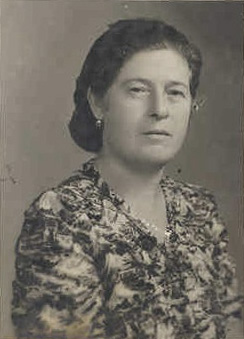
Doc. 5 Vincenza Di Lernia, my grandfather’s Policarpo’s sister.

Doc. 6 My grandfather’s Policarpo baptism certificate (Rosaire Baptisatorum I 021). His godmother was Anna Dellerno, probably a cousin, daughter of Giuseppe, son of Spiridione, and Francesca Collaro. Five years later, in 1910, she will marry Michele Tito.

Doc. 7 The record of Luca Di Lernia’s baptism (Rosaire_Baptisatorum_I_105), godfather Francesco Scagliarini, and death (Rosaire_Mortuorum_1_054)

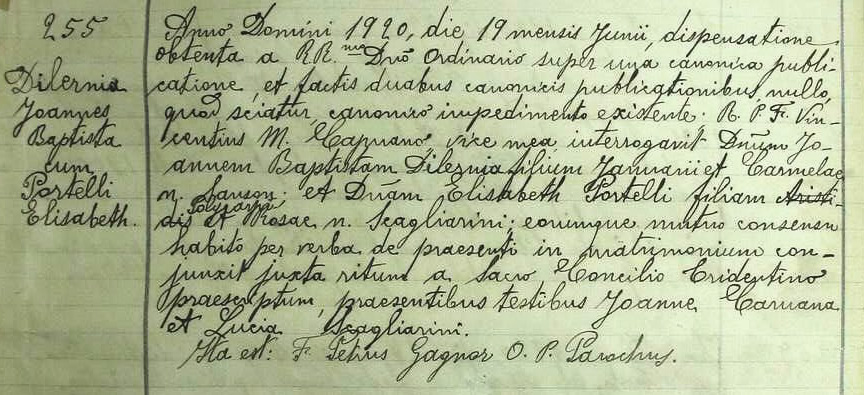
Doc. 8 Giovanni Battista and Elisabeth Portelli’s wedding certificate. Here the name is written Dilernia. (Rosaire_Matrimoniorum_I_086). Witnesses were Giovanni Caruana and Lucia Scagliarini
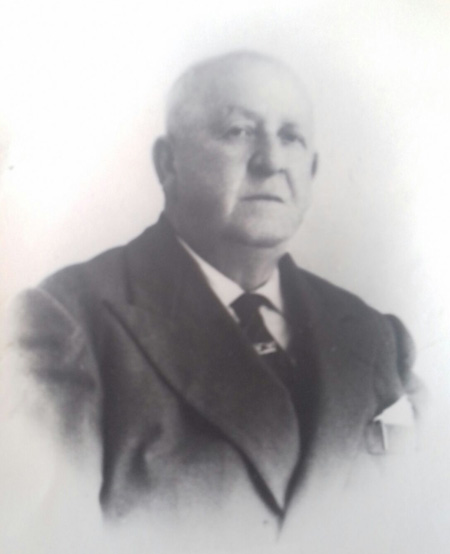
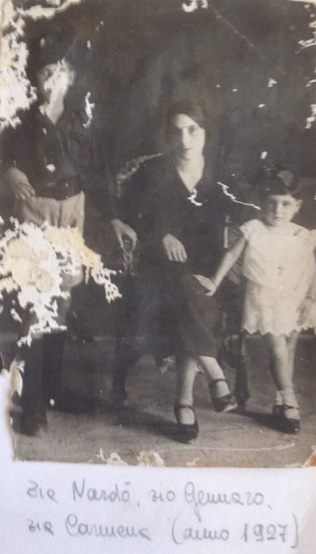
Doc. 9 Francesco “Franzi” Di Lernia and his wife Leonarda “Nardò” Tito with their children Gennaro and Carmela “Carmena”. Photos kindly sent by Antonella Tito
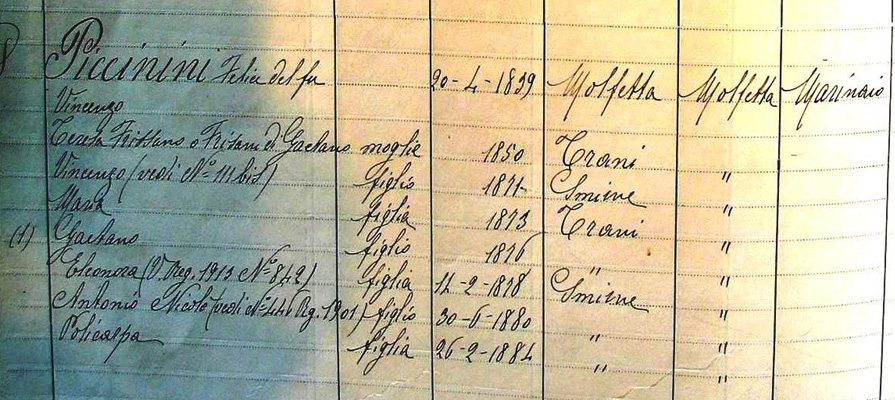
Doc. 10 The Italian Consulate register, where the family of Felice (Filippo) was registered, probably in 1884, being missing the last three children. What looks strange is the fact that also Luigi, who was born in 1882, is not recorded

Doc. 11 The register of deaths of Holy Rosary Church, where the death of (Filippo) Felice Piccinini is registered (Rosaire_Mortuorum_1_054)

Doc. 12 My great grand-father Nicola Piccinini’s certificate of baptism from the Cathedral register (Cat. Baptisarum1_176). His godparents were Victor Manghir and Helena Pirghouly. Note that the surname has been corrected, both on father’s and son’s name, from Pezzinino to Piccinino (or Piccino?). In the margin, the recording of his wedding.

Doc. 13 My great-grandmother Teresa’s certificate of baptism (Cat. Baptisarum 1_245). Her godparents were Alessandro Delari and her mother’s cousin Virginia Verdori, who will become her uncle Antonio Mazzei’s wife the following year.
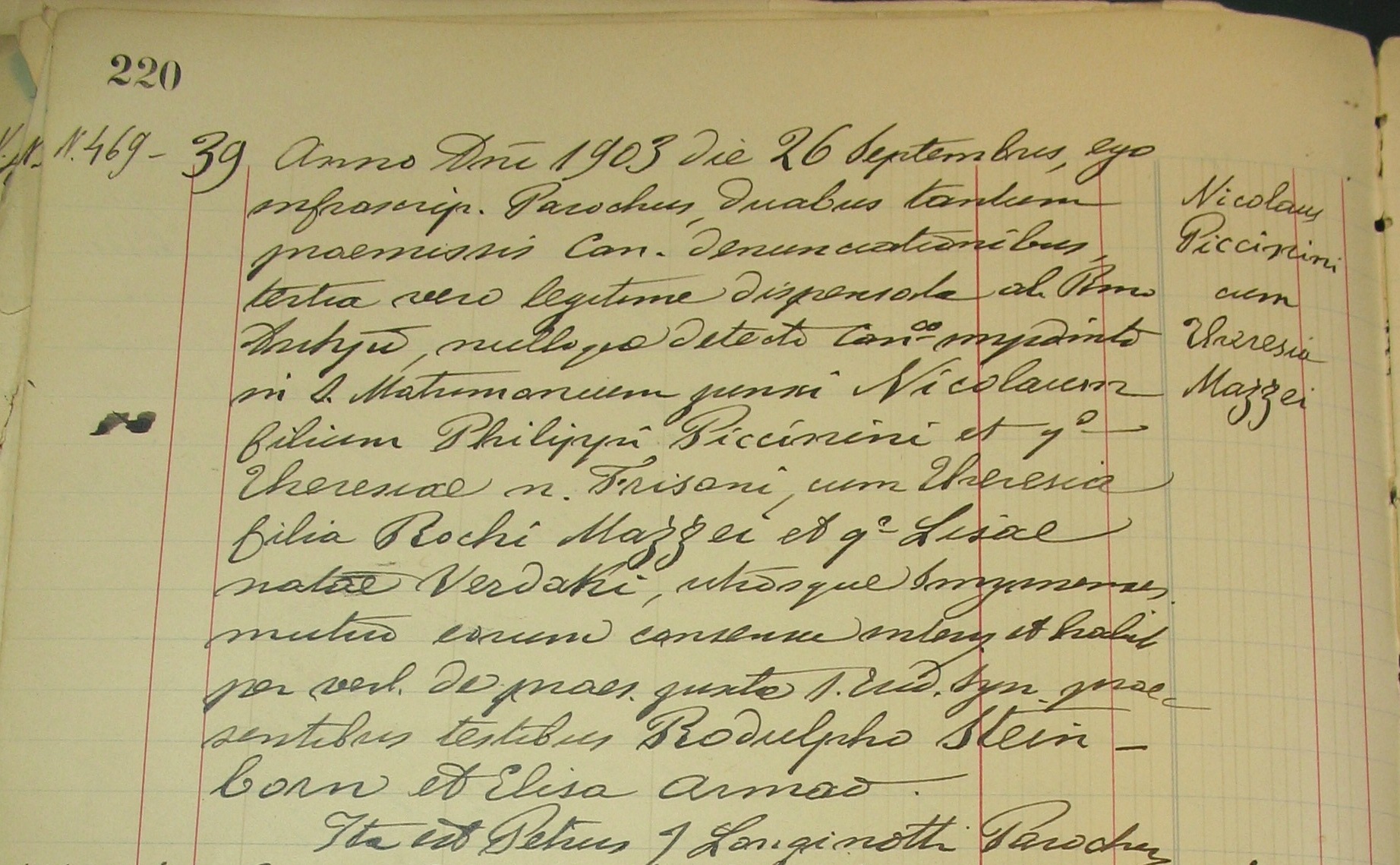
Doc. 14 The register of Izmir Cathedral (Cathedrale_matrimonorum_II_223) recording the wedding of Nicola and Teresa, being witnesses Rudolph Steinborn and Elisa Armao
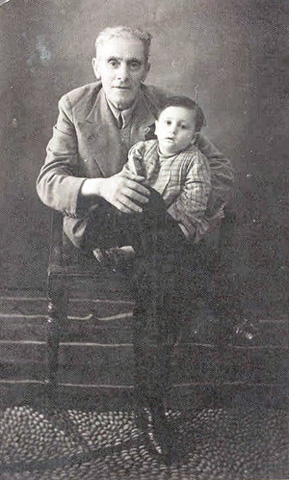
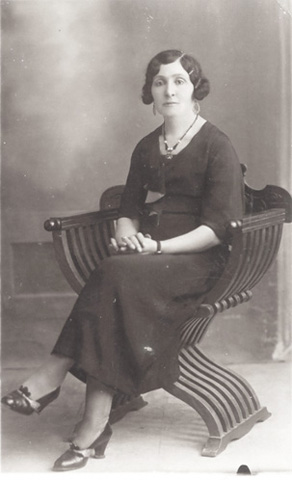
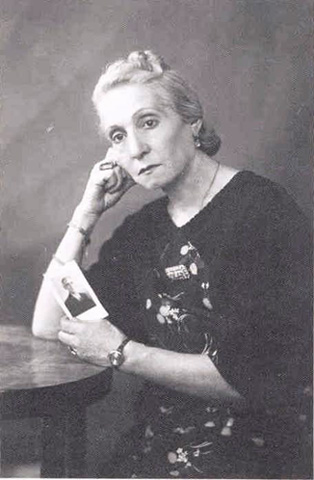
Doc. 15 Egidio Mazzei, my great grandmother Teresa’s brother, in 1942 in Rhodes, with Carletto Piccinini, grandchild of his sister Teresa, being son of her son Vincenzo and Angela Scagliarini.
According to family tales, Egidio was a musician: he used to play piano and harp, that he had in the house in Rhodes where he lived with my great grand-parents.
Doc. 16 Two pictures of Maria Mazzei: as a young lady in Izmir and, later, in Rhodes, holding the picture of her partner Gioacchino.

Doc. 17 The registration of Vincenzo Piccinini’s baptism, celebrated in Izmir Cathedral (katedral Bapt.3_079)

Doc. 18 The baptism of Felice Piccinini’s was celebrated in the Holy Rosary Church (Rosaire_Baptisatorum_I_034), godfather Lucas Cauki. Note that the annotation “morto 1911” is wrong (in fact he died in 1909): he was mistaken with his grandfather Filippo Felice, who died that year
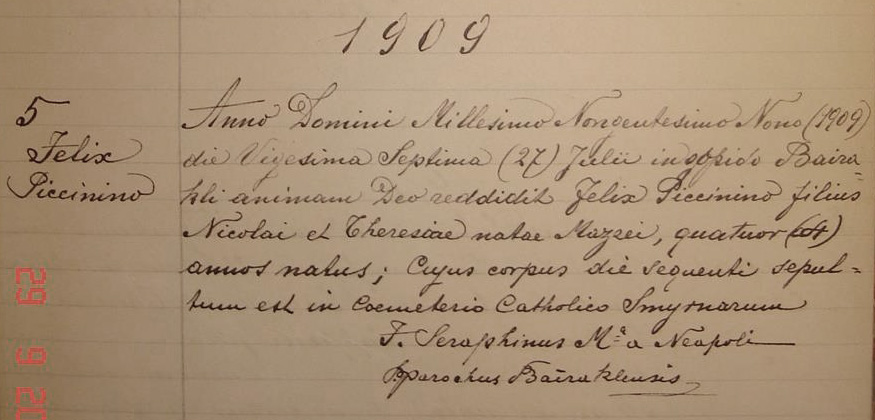
Doc. 19 The record of Felice’s death (Bayraklı JC3 139) in the register of the church of St Antony in Bayrakli
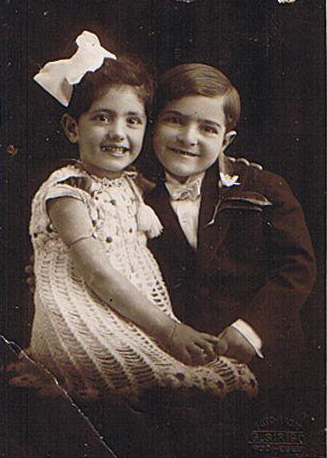
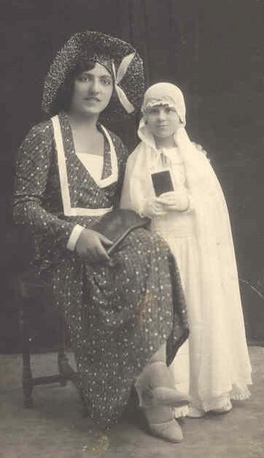
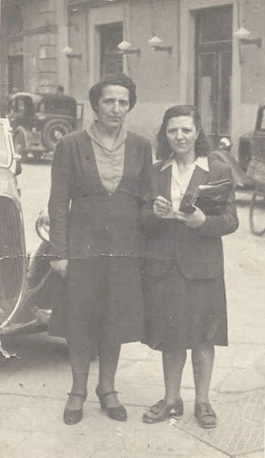
Doc. 20a A beautiful picture of Vincenzo and Laysa Piccinini dating at years 1912-13, kindly sent by my cousin Maria Rita Piccinini, Francesco’s daughter
Doc. 20b My grandmother Laysa, in Rhodes, around 1933, on the occasion of the Holy Communion of a child I do not know
Doc. 20c Laysa, on the left, and her sister Pola Piccinini, in Bari around 1946
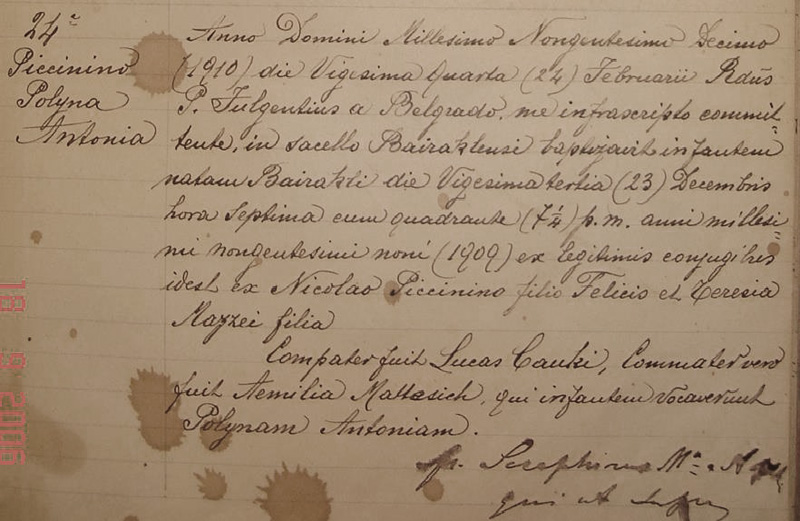
Doc. 21 Pola Piccinini’s baptism record
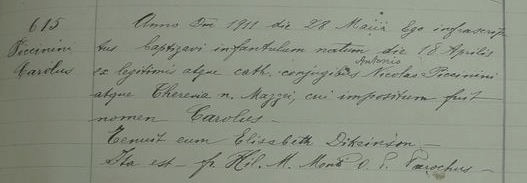
Doc. 22 The baptism of Carlo Piccinini in the register of the Holy Rosary Church (Rosaire_Baptisa-torum_I_133)
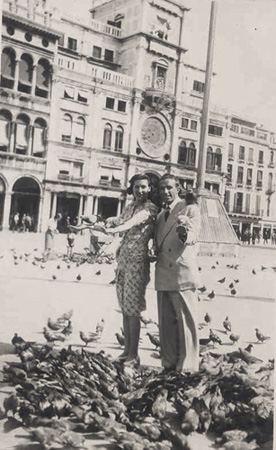
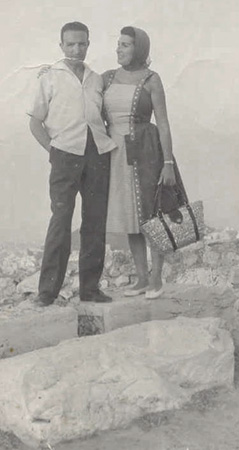
Doc. 25 Felice Piccinini and his wife Nina Koukakis (or Coccachi), born in Izmir too. The picture on the left is taken in Venice, the one on the right at the Acropolis, in Athens.
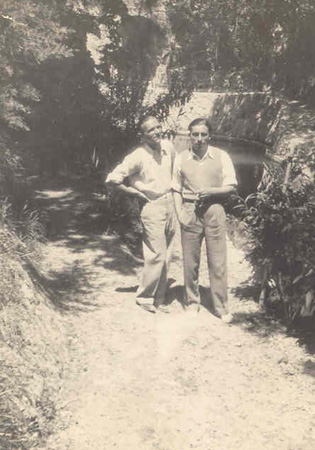
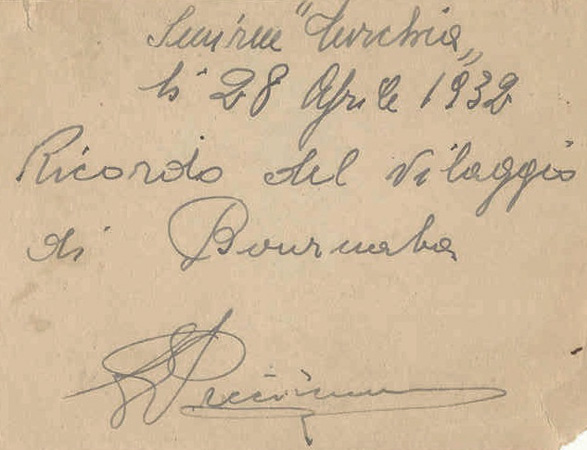
Doc. 23 Egidio Piccinini, on the left, with a friend. As written on the back, this picture was taken during a journey he made in April 1932 to the village of Bournabat, where he had spent some years when he was a child. At the time of this trip he was 19 and he lived with his family in Rhodes.
It seems that he was used to travel, since the year before, in July 1931, he had been in Congo; I don’t know whether he was working there or he went on holiday.
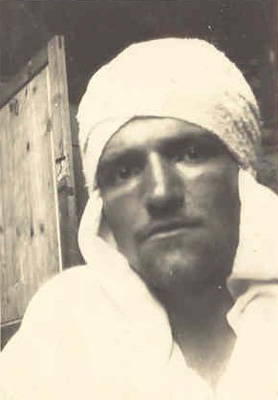
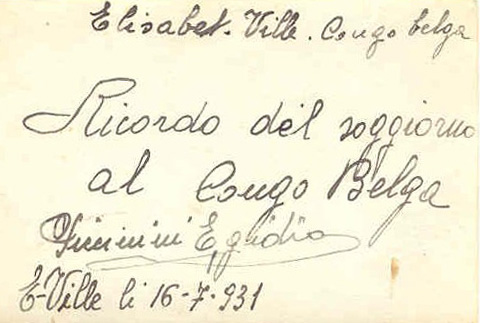
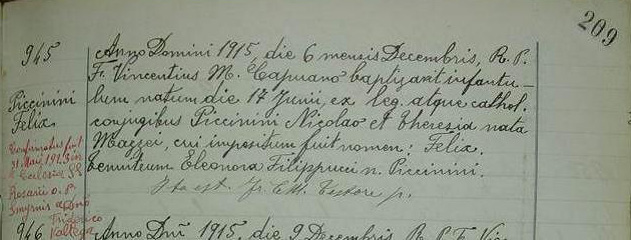
Doc. 24 The baptism of Felice Piccinini in the register of the Holy Rosary Church (Rosaire_Baptisatorum_I_206). The note in red refers to his confirmation celebrated in the same temple on May 31, 1923
Doc. 26 Francesco Piccinini’s certificate of baptism
Doc. 26b Francesco Piccinini with his mother Teresa in a photo dating back, probably, to the years ’30s, when they were living in Rhodes.
Doc. 27 The “One-way pass” issued to my grandfather Policarpo on March 1926
Doc. 29 My grandfather Policarpo during his military service from 7 June 1926 to 7 October 1927.
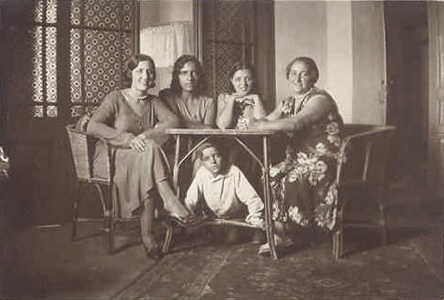
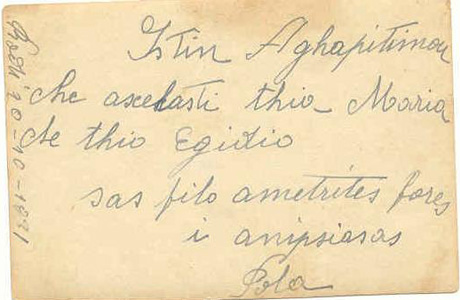
Doc. 28a The Piccinini ladies in Rhodes. From right: Teresa Mazzei, Pola and Laysa Piccinini, a cousin whose name I do not know and, under the table, the younger son, Francesco Piccinini.
The picture was taken on October 20, 1931, as written on the back side, so my grandmother Laysa was 23 years old, her sister Pola 22 and their brother Francesco 7
Doc. 28b The back side of the photo with an inscription by Pola in Levantine greek: Stin aghapitimou che axehasti thia Maria che thio Egidio. Sas filo ametrites fores i anipsiasas Pola
(To my beloved dear aunt Maria and uncle Egidio. I send you many kisses, your niece Pola).
The addressees were her mother’s brothers, Maria and Egidio Mazzei.
Doc. 30 My grandparents’ certificate of wedding
Doc. 31 The travel document of my father’s family transfer to Italy
Doc. 34 This is the communication that the Pope’s Secretariat took upon itself to sent to families of war prisoners to inform them about the fate of their relatives
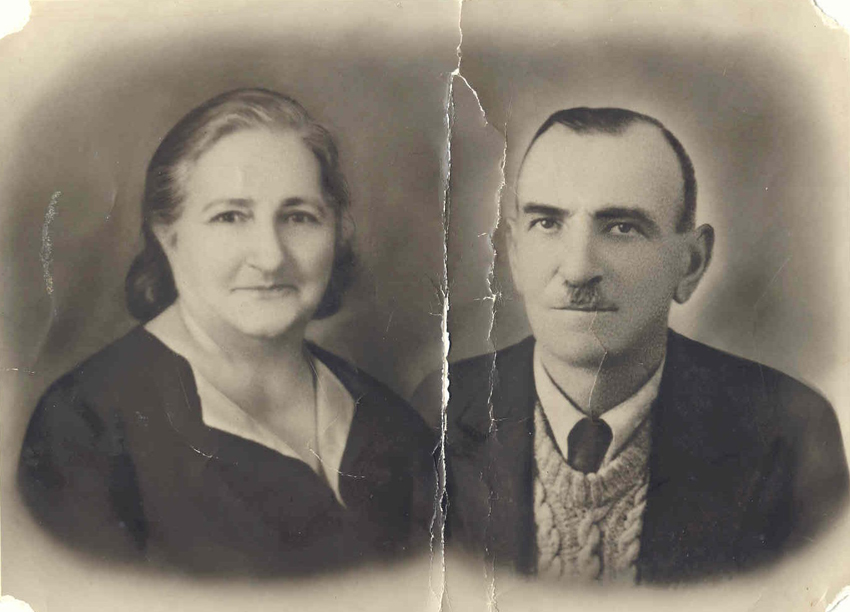
Doc. 32 Teresa Mazzei and Nicola Piccinini in 1940, when Teresa was 58 years old and Nicola 60. Unluckily, the picture is in very bad conditions, having been used for the funerary monument.
They both died in Villafranca di Verona, Nicola on 22nd March 1957 and Teresa on 28th February 1964, and are buried in the local cemetery
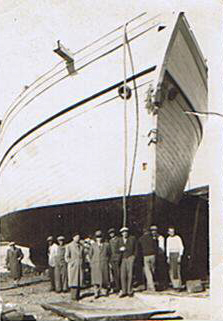
Doc. 33 My great-grandfather Nicola’s last ship, the Irene, launched at Molfetta (courtesy of Maria Rita Piccinini)
1 The sources for this article consist of parish and Consulate registers, which I didn’t see personally. A great contribution comes from the precious work of Marie Anne Marandet (her database called Marmara2) and the group of descendants of the Levantine families she works with. Regarding the registers of the Italian Consulate in Izmir, they were compiled starting from 1871, ten years after Italy became a united nation. Before this date the Italians coming from southern Italy were subjects of the Kingdom of Sicily and Naples, but there are not Consulate registers in Izmir for that period (only the Consulate in Constantinople compiled them). So for the period preceding the Unification of Italy the most precious source have been the registers of the various parishes to which the Italian residents turned for the marriages, the baptisms and the dead. Another very important source was the Archives of the City of Trani from which, thanks to the research of Mr. Pasquale Palone, I was able to reconstruct the genealogy of Trani dating back to the early '700. Invaluable then the help of Mr. Saverio Cortellino, a deep connoisseur of the archival documents relating to Trani and the province of Bari, who helped me to reconnect the data of the emigrants in Izmir with those of the Italian archives and to recover the transcripts sent to Trani by the Consulate of Izmir.
2 This note appears in some records: “Il cognome Delerno è stato cambiato in Di Lernia”
3 This “terminus ante quem” is given by the fact that, when the Italian Consulate began the registration of the Italian citizens, the wives were registered as “widow of…”, so we can only infer that the husband had died before the year of registration”
.
4 From an analysis of the notes of the consular register it seems probable that these two Domenico are the same individual, remained widower of the first wife and then remarried. In fact, in the notes related to his daughter Eugenia (born about 1851) it is written "daughter of Domenico and Maria Mastropasqua" (although she is among the sons of Domenico and Maria Carabotti or Carabetti) and this could lead to suppose that the first three children of Domenico (Nicola, Emanuele and Eugenia) were born from the marriage with Maria Mastropasqua between 1848 and 1851, while the first son of Domenico and Maria Carabotti, Pasquale, was born in 1855. Such inaccuracies are not uncommon in the registers and are often caused by unclear distinctions between first and second marriage children.
5 Documents from the Trani archive were important in establishing that the last two Delerno, Francesco and Vincenzo, were not brothers, although both were sons of Giuseppe, since their mothers were different. Giuseppe Delerno, with his wife Maria Desanti, must have emigrated before 1848 to Smyrna, where Vincenzo was born, while Giuseppe, Francesco’s father (born in Trani in 1789 and died in Trani on April 29, 1864) probably never moved from Italy.
6 Biagio Salvemini, Comunità separate e trasformazioni strutturali. I pescatori pugliesi fra metà Settecento e gli anni Trenta del Novecento, in: “Mélanges de l'Ecole française de Rome. Moyen-Age, Temps modernes” T. 97, N°1. 1985, pp. 441-488 (the article can be read in http://www.persee.fr/web/revues/home/prescript/article/mefr_0223-5110_1985_num_97_1_2810).
7 In 1827 a commercial treaty was signed between the Kingdom of Naples (to which Apulia belonged) and the Ottoman Empire. According to this treaty, the ships flying the flag of this Kingdom could make free trade in the Levant and this was a great business opportunity for Apulian ship-owners (generally the fishermen owned their boats).
8 Giuseppe had a longer life than his father (he died on May 29th 1932, at the age of 70) and got married three times: in 1888 with Teresa Accoto (born in 1865) who gave him four children (Francesco in 1890, Antonio in 1891, and the twins Emilia and Maria Lucia in 1893) but died, only 28, ten days after the twins childbirth, on 1894. Unfortunately, also the twins did not survive: Emilia died at the age of 8 months, Maria Lucia when she was 3. So Giuseppe in 1895 married his first wife’s sister, Giovanna Accoto, from whom he had three more children: Teresa in 1896, Giuseppe Pasquale in 1897 and Policarpo Antonio in 1898. Giovanna died young too, at 32 in 1901, and in 1903 Giuseppe got a third wife, Antonia Cosentino, who, at the age of 40, gave him his eighth child, Emanuela, in 1904.
9 Rosa was born on June 1st 1866 and had two husbands: Giuseppe Caporeale, born in Bari, whom she married in 1883, from whom she had 5 children (Michele, Victoria, Michele, Teresa, Anna Camporeale) from 1855 to 1896, and Antonio Musmus, married in 1900, from whom she had 4 more children (Francesco, Marie, Polycarpe and Lucia Musmus) from 1901 to 1907. Rosa died in Izmir on December 8th 1938.
10 Policarpo was born on September 28th 1872 and married Anna Tito (born in 1878) in 1897.
11 Antonio was born on May 29th 1874 and in 1900 he married Margherita De Lucia. They had seven children: Francesco (married with Maria Policarpina Portelli), Antonio, Luigi (married with Maria Rosaria Bassi), Policarpo, Carmelo, Paolo and Vittorio.
12 Pasquale was born on June 24th 1877 and died in 1915. He was married with Caterina Marinaro and they had four children: Francesco, Teresa Giovanna (married with Giorgio Gheracaris), Spiridione and Maria.
13 Nicola was born on January 16th 1879 and married in 1904 Marianthi Caluta, from whom he had three children, Teresa, Francesco and Giovanni.
14 I have no evidence of this story, since the surname Sanson or similar (Sansum, Sansone etc.) seems to be unknown among the names of residents in Malta from 1700 on, while I found there some Cremona (Carmela’s mother family), but I don’t know if they belong to the same family. The only link I found between the Sanson and Malta is in the list of Maltese seamen in the Royal Navy: a certain Antonio Sansone, 362523, born in Valletta on 20th February 1881, joined the Royal Navy in May 1904 on board HMS Illustrious as a bandsman, but left in November 1905. Could he be the Antonio Sanson who appears in the Izmir documents? Anthony was Carmela’s brother. He married with Josepha Vierda and had seven children: Elena (who married in 1917 Antonio Karakukaki), Paola Maria, Francesco Battista (married in 1922 with Euphrasie “Francesca” D’Andria), Maria Pasqualina (who married, the same day of his brother, Policarpo Tito), Policarpo, Emilio and Odetta.
I recently got in touch with Antonella Tito, a descendant of Policarpo Tito and Maria Pasqualina “Lilly” Sanson, who confirmed the relationship between Carmela and Antonio Sanson and the Scottish origin of the family. She also provided me with precious photos, including that of my great-grandfather Gennaro.
Another Sanson was living in Izmir in those years, Michel, who married in 1906 Anne Elisabeth Cauki and in 1924 Thérèse Bretin.
15 In 1915 Uncle Franzi had married Maria Leonarda Tito, called Nardò, born in Izmir on February 10th 1893. They had four children: Gennaro, Bartolomeo Giuseppe, Bartolomeo and Carmela Maria, but only Gennaro and Carmela survived (See Doc. 9). After 1923 they moved to Rhodes, where Franzi died after a long illness. The episode surrounding uncle Franzi’s death was a very sad and shocking one. It happened in 1944, when the island was bombed every day. Franzi’s body had to be left unattended in the house, because the warning forced everybody to rush to the shelter. When my grandfather Policarpo came back, he found his brother’s body attacked by rats, themselves compelled by hunger, like the whole population. Aunt Nardò, Gennaro and Carmela went back to Italy as refugees in 1945: after a short stay in Bari, they were sent to Naples (Aversa), where they settled. Carmela had married in Rhodes a guy of the Maglione family, from Casoria (Naples).
16 Giuseppe got married in Rhodes with Marialuisa Ricciardi, born in Izmir in 1920, and had two children, Gino and Carmela, who remained orphans very early: their mother died under one of the first bombing by the RAF on August 27, 1941, at the age of 21. When they arrived in Italy with the other refugees they stayed few months with their aunt Vincenza and with my grandmother Laysa, but later they had to be hosted in an orphanage. Giuseppe died in 1966.
17 Another Piccinini appears in the register of weddings of the Saint Mary Draperis Church in Istanbul: in 1886 Marie Hortense Piccinini, daughter of Lazzaro, already dead by that year, married Frédéric Testa.
18 Other Frisani (or Frissano) were in Izmir in those years: a Francesca, married to Onofrio Bassi, and an Angiolina (or Angela), born in 1850 in Trani, and married to Giovanni Battista Fabiano. Considering that the names of the children of these three women are similar, it is possible that they were sisters (Teresa and Angiolina, twins?), daughters of Gaetano and Eleonora Fabiano, quoted in some Izmir documents as husband and wife. These women were surely linked, since Angiolina has been the godmother of three children of Felice’s and Teresa’s (Eleonora, Luigi and Angela).
19 Lacking other documents (for example the registration of baptism), I have some doubts about Vincenzo’s birth in Izmir, just two years before his sister, who was born in Trani: the family should have come back to Italy either with a newborn baby or with a little more grown up child, but with a pregnant wife. Vincenzo Piccinini was a boatman (“barcaiolo”). He died very young, when he was 28, in 1899. In 1893 he had married Carmela Galdies, from whom he had three children: Teresa Caterina, in 1894, who married in 1930 Giorgio Policarpo Ventura, Policarpo Salvatore in 1897, died in Buca in 1958, and Liberata Antonia, who married in 1919 Vittorio Braggiotti.
20 Maria Piccinini married in 1890 Joannes Vragnatz.
21 Gaetano Piccinini died in February 1877, when he probably was only 1 year old.
22 Eleonora Piccinini was born in 1878 and in 1894 married Vincenzo Filippucci from whom she had 9 children: Anna Teresa, Teresa Maria (married to Antonio Micaleff), Maria Teresa Agnese, Maria Filippucci-Cassar, Antonio (married to Maria Papagno), Agnese Rosa (who married her sister Teresa Maria’s husband Antonio Micaleff in 1924, probably after her sister’s death), Edoardo Antonio (married to Renée Sponza), Felicita (married with Giovanni Sponza) and Natalina Anna (married with Mario Tornaviti). Eleonora died in 1945.
23 Luigi Piccinini was born in 1882 and died in 1894 at the age of 12.
24 Policarpa Piccinini was born in 1894 and in 1903 married Policarpo Copparoni.
25 Angela and Anna Piccinini lived very shortly: the first was born on October 15th 1885 and died one month later; the second was born in 1888 and died when she was two years old.
26 Angela Anna Piccinini was born in 1889 and in 1906 married Giovanni Juane Serra. They had 4 children: Tommaso Tommy (married with Domenica Vassallo), Felice, Rosa (married with John Papi), and another Felice.
27 See note 6.
28 Rocco was the son of Egidio Mazzei and Teresa Zitto and had a brother, Antonio, who moved to Izmir too. The two brothers married two cousins: Rocco Elisabetta (Laisa) Verdori and Antonio Virginia (aunt Virginie) Verdori, daughter of Giorgio Verdori’s and Antoinette Armao’s.
29 See the baptism certificate of her nephew Francesco Piccinini, of whom she and her new husband were godparents.


